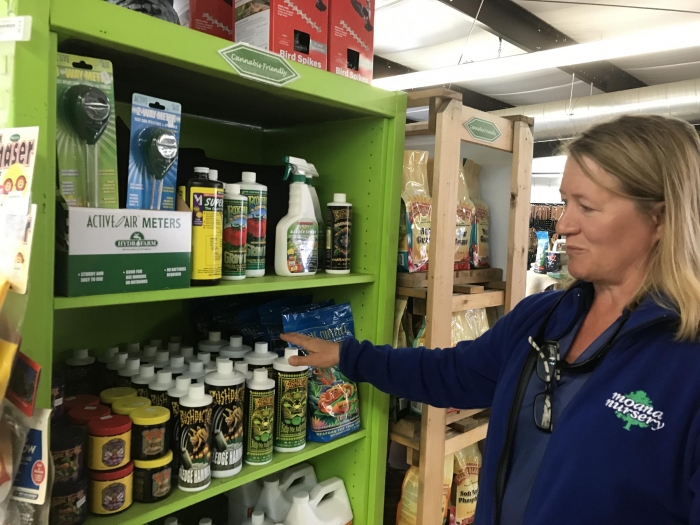You are here
Home 🌿 Recreational Marijuana News 🌿 Growing Cannabis At Home Requires More Than Green Thumb 🌿Growing Cannabis At Home Requires More Than Green Thumb

Nearly twenty-eight thousand Nevadans are currently cardholders in the state’s medical marijuana program. And about thirty-five hundred are registered as home growers. Contrary to what some might think, weed isn’t that easy to grow. Reno Public Radio’s Anh Gray explores some issues patients encounter while cultivating at home.
An array of flowers, fruit trees and vegetable plants are on display at the at Moana Nursery located in Southwest Reno. With the warmer weather, customers are snapping up plants and fertilizers.
Over in a corner, a few customers are quizzing horticulturalist Laura Braginton, AKA “the plant doctor,” about how to care for some dwarf peach trees.
In the last few years, Braginton’s expertise has also been sought from people interested in growing cannabis.
“Like most plants, there’s a lot of complexity to it,” Braginton says.
Medical marijuana was legalized by voters in a ballot initiative back in 2000. But dispensaries were not available for another 15 years.
Nevada lawmakers did set up provisions allowing patients registered in the state’s medical marijuana program to grow their own. Some of those rules include growing only a limited amount in an enclosed area and residing 25 miles away from a dispensary. Over the years, home cultivators have been showing up at the nursery with questions.
“The biggest thing, you know, I refer to people who would come in and they would skirt around what they wanted to ask about, ‘Oh your growing winter tomatoes indoors.’ Got it,” Braginton explains that some people might be skittish about disclosing to her that they need advice about growing cannabis indoors.
Braginton says she doesn’t have direct experience growing cannabis, so instead she dispenses general tips about how to garden successfully. And since Nevada requires home growers to plant away from public view, many are growing in sheds or greenhouses.
“A lot of people overlook how much light plants need indoors,” Braginton says explains. “They think, ‘oh it’s light inside, or I’ve got the light on, or there’s a window.’ That’s not enough to grow marijuana successfully.”
And there are other dilemmas as well.
“We’re seeing them come in with, you know, the afids, the powdery mildew on the leaves,”Braginton says, “and in the absence of naturally occurring beneficial insects outdoors, your pest problem tends to multiply indoors, and so we’d probably be able to have healthier plants in the right micro-environment outdoors.”
Diane who’s living in northern Nevada can relate to those issues. She asked us not to use her last name to protect her privacy.
Diane registered for the medical marijuana program several years ago to treat chronic pain. She discovered that for her, pot was more effective than prescription painkillers. And since she’s got a green thumb, she produced her own strain.
“I’m a horticulturalist, I walk in and I go, ‘Oh look I have spider mites, so I spray it. Oh, look I have white fly. Oh, look I’m getting fungal disease, I need to dry out the green house,” Diane explains that these are a few of the challenges she encounters while growing cannabis in her greenhouse. “That’s the kind stuff that the average person is not going to know.”
Diane says for those with a black thumb, going to a dispensary would not only be less of a hassle, it could also be safer.
“I’m sure that a lot people are smoking bug carcasses and fungus spores on their pot,” Diane says.
Toxicologist Jason Strull is with 374 Labs in Reno. His facility tests cannabis primarily for businesses but he’s also got a few clients that are home growers.
“I think the biggest concern is the potential for microbial contamination,” Strull says. “That's the one thing that’s hard for a lot of growers to control and they don’t really know if they have it in their products if they are growing it at home without it getting tested.”
In addition to concerns about microbial contaminants, potency can also be an issue, especially for edibles.
“Making the edibles, that’s where it gets more complicated too with not knowing what the potency is,” Strull explains. “The effects of the edibles can take up to two hours to kick in so you can be sitting waiting to not know how potent it’s going to be when you ingest it.”
But for professionals, the state requires stringent labeling. For the production of edibles, cultivators selling to dispensaries must include information like the date of harvest, a final testing date, and the potency level that’s been verified by an independent testing laboratory.
As of May 2017, there are more than 50 medical marijuana dispensaries scattered throughout Nevada, giving patients more options than ever.
420 Intel is Your Source for Marijuana News
420 Intel Canada is your leading news source for the Canadian cannabis industry. Get the latest updates on Canadian cannabis stocks and developments on how Canada continues to be a major player in the worldwide recreational and medical cannabis industry.
420 Intel Canada is the Canadian Industry news outlet that will keep you updated on how these Canadian developments in recreational and medical marijuana will impact the country and the world. Our commitment is to bring you the most important cannabis news stories from across Canada every day of the week.
Marijuana industry news is a constant endeavor with new developments each day. For marijuana news across the True North, 420 Intel Canada promises to bring you quality, Canadian, cannabis industry news.
You can get 420 Intel news delivered directly to your inbox by signing up for our daily marijuana news, ensuring you’re always kept up to date on the ever-changing cannabis industry. To stay even better informed about marijuana legalization news follow us on Twitter, Facebook and LinkedIn.






